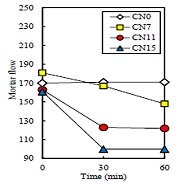Fresh Properties and Strength Development of Cement Mortar Using Nitrite-based Accelerator and Chemical Admixtures
Keywords:
nitrite-based accelerator, high-range water-reducing agent, mortar flow, compressive strength, cold-weather concreteAbstract
A nonfreezing agent prevents initial frost damage by simplified curing and also promotes early strength development. In general, a nitrite-based accelerator is used as the main component of this nonfreezing agent. When a large proportion of a conventional accelerator is used, the slump loss increases because the setting and hardening processes are strongly enhanced. In addition, these conventional accelerators may not be sufficiently effective at temperatures of -10 °C or less. Therefore, the fresh properties and strength development of cement mortars when using a nitrite-based accelerator and chemical admixtures in a low-temperature environment are examined. The objective is to develop a high-performance nonfreezing agent. This paper presents the contributions of the nitrite-based accelerator and two types of high-range water-reducing agents, used in combination. From the investigation, it was confirmed that the change in the mortar flow can be suppressed by combining two types of high-range water-reducing agents with a nitrite-based accelerator, even after the passage of 60 min after mixing. Furthermore, the mix was found to contribute to not only the initial strength but also toward maintaining the good strength for a longer time.References
T. Aakama, M. Inoue, Y. Sudoh, and S. Mikami, “Fresh properties and early strength development of concrete using calcium nitrite and water-reducing agents,” Proc. of the Japan Concrete Institute, vol. 34, pp. 155-159,July 2012. (In Japanese)
M. Iwasawa, M. Inoue, H. Choi, Y. Sudoh, and K. Ayuta, “Characteristics of concrete using nitrite-based accelerator and chemical admixtures in low-temperature environments,” Proc. of the 7th International Conference of Asian Concrete Federation, pp. 1-8, October 2016.
M. Iwasawa, M. Inoue, H.Choi, and Y. Sudoh, “Study on Deformation Bahavior of Concrete Large Amount of Using Nitrite-Based Accelerator,” Proc. of the Japan Concrete Institute, vol.39, pp.115-120, June 2017. (In Japanese)
M. Iwasawa, M. Inoue, H. Choi, and Y. Sudoh, “The Fundamental Study on the Expansion and Shrinkage Behaviors of Concrete Using Nitrite-based Accelerator,” Proc. of the 2017 World Congress on Advances in Structural Engineering and Mechanics, p.1-11, August 2017.
Y. Hama and E. Kamada, “ The Properties of Concrete Containing a Frost-Resistance Accelerator,” Concrete Journal, vol.37, No.1, pp.3-8, November 1999. (In Japanese)
V. S. Ramachanran, Concrete admixture handbook, U.S.A.: Noyes Publications, 1995.
Concrete Institute of Japan in Hokkaido Branch, Research committee report on the latest technology of concrete admixtures, pp. 76-79, 2011. (In Japanese)
S. Takii, S. Hiraoka, T. Okamamoto, N. Masuyama, Y. Nagakawa, Y. Sudoh, M. Inoue, and D. Atarashi, “Search for mix proportions of concrete for pavement in early traffic opening is possible and its practicality,” Journal of Japan society of civil engineers, vol. 70, no. 1, pp. 1-10, 2014. (In Japanese)
Practical Guideline for Investigation, Recommendation for practice of cold weather concreting, Architectural Institute of Japan, 2010. (In Japanese)
Y. Hama and E. Kamada, “Effects on protection fresh concrete against frost damage by non-chloride and non-alkali type antifreezing admixtures,” Concrete Research and Technology, vol. 7, no. 1, pp. 113-122, 1996. (In Japanese)

Published
How to Cite
Issue
Section
License
Submission of a manuscript implies: that the work described has not been published before that it is not under consideration for publication elsewhere; that if and when the manuscript is accepted for publication. Authors can retain copyright of their article with no restrictions. Also, author can post the final, peer-reviewed manuscript version (postprint) to any repository or website.

Since Oct. 01, 2015, PETI will publish new articles with Creative Commons Attribution Non-Commercial License, under The Creative Commons Attribution Non-Commercial 4.0 International (CC BY-NC 4.0) License.
The Creative Commons Attribution Non-Commercial (CC-BY-NC) License permits use, distribution and reproduction in any medium, provided the original work is properly cited and is not used for commercial purposes



